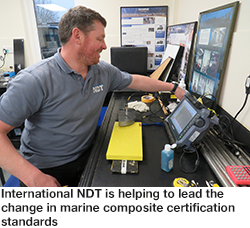Lavender develops bespoke marine composite course tailored to meet industry needs
24/04/2020
 Composite material in marine applications has been used for several decades. Its cost-effective, lightweight properties provide excellent durability, a higher level of resistance to corrosion and improved efficiency for long-lasting performance[1]. To date, composites have been utilised for a variety of components and structures within the marine industry, including work boats, leisure craft, racing yachts, super yachts and powerboats. Yet, unlike most other engineering sectors, there is currently no standard tailored towards marine composite inspection that outlines mandatory certification requirements for individuals performing non-destructive testing (NDT) on marine structures.
Composite material in marine applications has been used for several decades. Its cost-effective, lightweight properties provide excellent durability, a higher level of resistance to corrosion and improved efficiency for long-lasting performance[1]. To date, composites have been utilised for a variety of components and structures within the marine industry, including work boats, leisure craft, racing yachts, super yachts and powerboats. Yet, unlike most other engineering sectors, there is currently no standard tailored towards marine composite inspection that outlines mandatory certification requirements for individuals performing non-destructive testing (NDT) on marine structures.
Without a standard in place, inspectors are not technically required to undertake any specific training or relevant NDT work experience to be able to provide the inspection, creating complications for those who are responsible for ensuring the safety of the boat and making sure it is fit for purpose. This increases the risk of flaws going undetected, jeopardising the structural integrity of the boat, potentially shortening the operating life of the vessel and could, in the worst case scenario, result in loss of life.
In 2015, Lavender International collaborated with Richard Freemantle at Wavelength NDT to develop a bespoke marine composite training course written to EN 4179/NAS 410/SNT-TC-1A certification standards for the team at International NDT, the NDT division within Marine Results International Ltd that specialises in inspecting marine composites or metallic parts using non-destructive methods.
This bespoke marine composite course, which is supplementary to a Level 2 ultrasonic testing training course, covered an overview of ultrasonics and audible sound, aspects of phased array, bond testing, tap testing, composite materials and product technology. The students had access to an extensive sample library, which consisted of mast sections, hull and deck laminates and composite rigging components of different dimensions, thicknesses and material types. All of the students successfully passed the course and came to recertify this year to ensure that their training qualifications are up to date.
“We are proud to be working with Lavender International and Wavelength NDT to have developed this bespoke course that specifically fits the needs we see for our inspectors, specialising in composite components. Our recertification course this year reinforced the value we see in this structured training and examination, which we see as essential to develop and demonstrate competency,” said Giles Waterhouse, Director at International NDT.
Looking ahead, International NDT is helping to lead the change in marine composite certification standards by working alongside BINDT, Lavender International and other key organisations in the marine industry, as well as an ISO committee, to develop the standard on the assessment of composite masts and rigging.
Lavender offers complete flexibility in the delivery of its training courses, ensuring that they are in line with internationally recognised standards and tailored to the specific requirements of its clients. It continues to work with accreditation bodies to further develop accreditation and best practice for NDT worldwide.
References
1. F Rubino, A Nisticò, F Tucci and P Carlone, ‘Marine application of fibre-reinforced composites: a review’, Journal of Marine Science and Engineering, Vol 8, No 1, 2020.
www.lavender-ndt.com